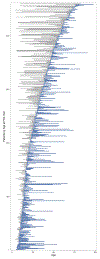A Retrospective Longitudinal Study of 460 Patients with ABCA4-Associated Retinal Disease
- PMID: 38309476
- PMCID: PMC11398085
- DOI: 10.1016/j.ophtha.2024.01.035
A Retrospective Longitudinal Study of 460 Patients with ABCA4-Associated Retinal Disease
Abstract
Purpose: To investigate the distribution of genotypes and natural history of ABCA4-associated retinal disease in a large cohort of patients seen at a single institution.
Design: Retrospective, single-institution cohort review.
Participants: Patients seen at the University of Iowa between November 1986 and August 2022 clinically suspected to have disease caused by sequence variations in ABCA4.
Methods: DNA samples from participants were subjected to a tiered testing strategy progressing from allele-specific screening to whole genome sequencing. Charts were reviewed, and clinical data were tabulated. The pathogenic severity of the most common alleles was estimated by studying groups of patients who shared 1 allele. Groups of patients with shared genotypes were reviewed for evidence of modifying factor effects.
Main outcome measures: Age at first uncorrectable vision loss, best-corrected visual acuity, and the area of the I2e isopter of the Goldmann visual field.
Results: A total of 460 patients from 390 families demonstrated convincing clinical features of ABCA4-associated retinal disease. Complete genotypes were identified in 399 patients, and partial genotypes were identified in 61. The median age at first vision loss was 16 years (range, 4-76 years). Two hundred sixty-five families (68%) harbored a unique genotype, and no more than 10 patients shared any single genotype. Review of the patients with shared genotypes revealed evidence of modifying factors that in several cases resulted in a > 15-year difference in age at first vision loss. Two hundred forty-one different alleles were identified among the members of this cohort, and 161 of these (67%) were found in only a single individual.
Conclusions: ABCA4-associated retinal disease ranges from a very severe photoreceptor disease with an onset before 5 years of age to a late-onset retinal pigment epithelium-based condition resembling pattern dystrophy. Modifying factors frequently impact the ABCA4 disease phenotype to a degree that is similar in magnitude to the detectable ABCA4 alleles themselves. It is likely that most patients in any cohort will harbor a unique genotype. The latter observations taken together suggest that patients' clinical findings in most cases will be more useful for predicting their clinical course than their genotype.
Financial disclosure(s): Proprietary or commercial disclosure may be found in the Footnotes and Disclosures at the end of this article.
Keywords: ABCA4; Cone–rod dystrophy; Retinitis pigmentosa; Severe juvenile-onset retinal dystrophy; Stargardt disease.
Copyright © 2024 American Academy of Ophthalmology. Published by Elsevier Inc. All rights reserved.
Conflict of interest statement
Conflicts of interest: there are no conflicting relationships for any of the authors.
Figures










References
-
- Molday LL, Rabin AR, Molday RS. ABCR expression in foveal cone photoreceptors and its role in Stargardt macular dystrophy. Nat Genet 2000;25(3):257–8. - PubMed
MeSH terms
Substances
Grants and funding
LinkOut - more resources
Full Text Sources
Medical

